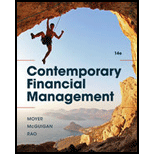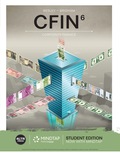
Contemporary Financial Management, Loose-leaf Version
14th Edition
ISBN: 9781337090636
Author: R. Charles Moyer, James R. McGuigan, Ramesh P. Rao
Publisher: South-Western College Pub
expand_more
expand_more
format_list_bulleted
Question
Chapter 5, Problem 1QTD
Summary Introduction
To discuss: Whether person X would prefer the proceeds from a 2 year investment pays 5% simple interest or from one paying 5%
Expert Solution & Answer
Explanation of Solution
Person X views that, he should prefer the investment that pays 5% compound interest annually, because in case of compound interest, he will receive interest not only interest on principal amount but also interest on interest for previous years.
Want to see more full solutions like this?
Subscribe now to access step-by-step solutions to millions of textbook problems written by subject matter experts!
Students have asked these similar questions
How do you calculate the intrinsic value of a stock using the dividend discount model (DDM)? Need help.
Explain the Modigliani-Miller theorem and its assumptions In finance?
How do you calculate the intrinsic value of a stock using the dividend discount model (DDM)? i need co
Chapter 5 Solutions
Contemporary Financial Management, Loose-leaf Version
Ch. 5.A - Prob. 1PCh. 5.A - Prob. 2PCh. 5.A - Prob. 3PCh. 5.A - Prob. 4PCh. 5.A - Prob. 5PCh. 5.A - Prob. 6PCh. 5 - Prob. 1QTDCh. 5 - Prob. 2QTDCh. 5 - Prob. 3QTDCh. 5 - Prob. 4QTD
Ch. 5 - Prob. 5QTDCh. 5 - Prob. 6QTDCh. 5 - Prob. 7QTDCh. 5 - Prob. 8QTDCh. 5 - Prob. 9QTDCh. 5 - Prob. 10QTDCh. 5 - Prob. 11QTDCh. 5 - Prob. 12QTDCh. 5 - Prob. 13QTDCh. 5 - Prob. 14QTDCh. 5 - Prob. 15QTDCh. 5 - Prob. 16QTDCh. 5 - Prob. 17QTDCh. 5 - Prob. 18QTDCh. 5 - Prob. 19QTDCh. 5 - Prob. 1PCh. 5 - Prob. 2PCh. 5 - Prob. 3PCh. 5 - Prob. 4PCh. 5 - Prob. 5PCh. 5 - Prob. 6PCh. 5 - Prob. 7PCh. 5 - Prob. 8PCh. 5 - Prob. 9PCh. 5 - Prob. 10PCh. 5 - Prob. 11PCh. 5 - Prob. 12PCh. 5 - Prob. 13PCh. 5 - Prob. 14PCh. 5 - Prob. 15PCh. 5 - Prob. 16PCh. 5 - Prob. 17PCh. 5 - Prob. 18PCh. 5 - Prob. 19PCh. 5 - Prob. 20PCh. 5 - Prob. 21PCh. 5 - Prob. 22PCh. 5 - Prob. 23PCh. 5 - Prob. 24PCh. 5 - Prob. 25PCh. 5 - Prob. 26PCh. 5 - Prob. 27PCh. 5 - Prob. 28PCh. 5 - Prob. 29PCh. 5 - Prob. 30PCh. 5 - Prob. 31PCh. 5 - Prob. 32PCh. 5 - Prob. 33PCh. 5 - Prob. 34PCh. 5 - Prob. 35PCh. 5 - Prob. 36PCh. 5 - Prob. 37PCh. 5 - Prob. 38PCh. 5 - Prob. 39PCh. 5 - Prob. 40PCh. 5 - Prob. 41PCh. 5 - Prob. 42PCh. 5 - Prob. 43PCh. 5 - Prob. 44PCh. 5 - Prob. 45P
Knowledge Booster
Similar questions
- How do you calculate the intrinsic value of a stock using the dividend discount model (DDM)?arrow_forwardHow does the weighted average cost of capital (WACC) affect a company’s valuation? i need help in this qarrow_forwardHow does the weighted average cost of capital (WACC) affect a company’s valuation?i need correct answer.arrow_forward
- How does the weighted average cost of capital (WACC) affect a company’s valuation?i need help.arrow_forwardHow does the weighted average cost of capital (WACC) affect a company’s valuation? Need helparrow_forwardHow does the weighted average cost of capital (WACC) affect a company’s valuation?arrow_forward
arrow_back_ios
SEE MORE QUESTIONS
arrow_forward_ios
Recommended textbooks for you
 EBK CONTEMPORARY FINANCIAL MANAGEMENTFinanceISBN:9781337514835Author:MOYERPublisher:CENGAGE LEARNING - CONSIGNMENT
EBK CONTEMPORARY FINANCIAL MANAGEMENTFinanceISBN:9781337514835Author:MOYERPublisher:CENGAGE LEARNING - CONSIGNMENT

EBK CONTEMPORARY FINANCIAL MANAGEMENT
Finance
ISBN:9781337514835
Author:MOYER
Publisher:CENGAGE LEARNING - CONSIGNMENT
